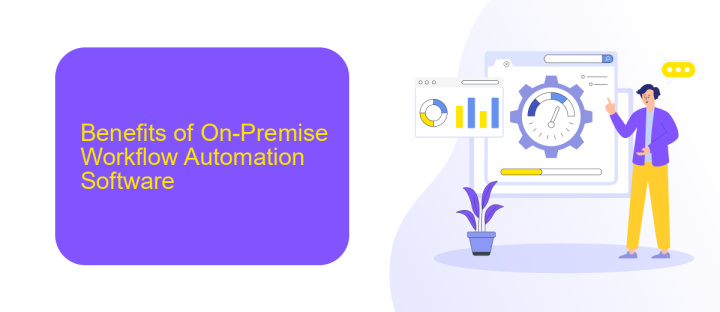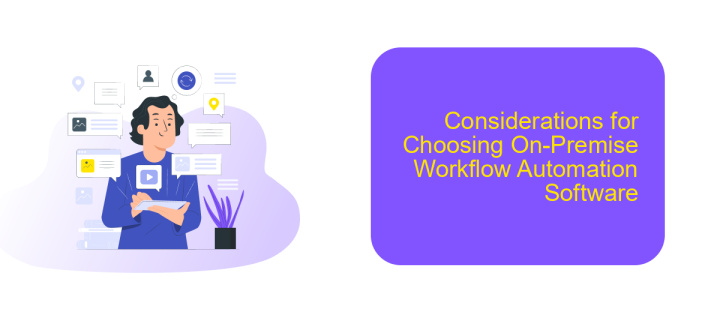On-premise Workflow Automation Software
On-premise workflow automation software is revolutionizing how businesses manage their internal processes. By automating repetitive tasks and streamlining operations, these solutions enhance efficiency, reduce errors, and save valuable time. Unlike cloud-based alternatives, on-premise software offers greater control, security, and customization, making it an ideal choice for organizations with specific compliance requirements and data privacy concerns.
What is On-Premise Workflow Automation Software?
On-premise workflow automation software is a type of system installed and operated from within a company's local infrastructure. Unlike cloud-based solutions, this software provides full control over data security, compliance, and customization, making it ideal for organizations with stringent data protection requirements.
- Enhanced data security and privacy
- Greater control over customization and integration
- Reduced dependency on internet connectivity
- Compliance with industry-specific regulations
One of the key advantages of on-premise workflow automation software is its ability to integrate seamlessly with existing local systems. Tools like ApiX-Drive can facilitate the integration process by connecting various applications and automating data transfers, ensuring smooth and efficient workflows. This level of control and customization allows businesses to tailor the software to their specific needs, enhancing productivity and operational efficiency.
Benefits of On-Premise Workflow Automation Software

On-premise workflow automation software offers unparalleled control and customization, allowing businesses to tailor solutions to their specific needs. This flexibility ensures that companies can adapt the software to their unique processes, enhancing efficiency and productivity. Additionally, on-premise solutions provide greater data security, as sensitive information is stored within the company's own infrastructure, reducing the risk of data breaches and ensuring compliance with industry regulations.
Moreover, on-premise automation software can seamlessly integrate with existing systems and tools. Services like ApiX-Drive facilitate these integrations, enabling businesses to connect various applications without extensive coding or technical expertise. This capability not only streamlines operations but also ensures that data flows smoothly across different platforms, enhancing overall workflow efficiency. By leveraging on-premise solutions, companies can achieve a higher degree of operational control and data protection, making it a valuable investment for long-term success.
Types of On-Premise Workflow Automation Software

On-premise workflow automation software comes in various forms, each tailored to specific business needs and operational requirements. These solutions help organizations streamline processes, reduce manual tasks, and improve overall efficiency.
- Business Process Management (BPM) Software: BPM solutions provide tools to model, implement, monitor, and optimize business processes. They are highly customizable and can integrate with existing systems to offer a holistic view of workflows.
- Robotic Process Automation (RPA) Software: RPA tools use bots to automate repetitive tasks, such as data entry and transaction processing. These solutions are ideal for enhancing productivity by minimizing human intervention in routine operations.
- Integration Platforms: Integration platforms like ApiX-Drive facilitate seamless connections between various software applications. They enable automated data exchange and synchronization, ensuring that all systems work harmoniously together.
- Document Management Systems (DMS): DMS solutions automate the management of documents, from creation to storage and retrieval. They support version control, access permissions, and workflow automation for document-centric processes.
Choosing the right type of on-premise workflow automation software depends on the specific needs of your organization. By carefully evaluating the options, businesses can implement solutions that significantly enhance operational efficiency and drive growth.
Considerations for Choosing On-Premise Workflow Automation Software

When choosing on-premise workflow automation software, it is essential to consider several key factors to ensure that the solution aligns with your organization's needs. First, evaluate the scalability of the software. As your business grows, your workflow automation needs will likely expand, so selecting a solution that can scale with your operations is crucial.
Another critical consideration is the software's integration capabilities. Ensure that the solution can seamlessly integrate with your existing systems and tools. For instance, ApiX-Drive offers robust integration services that facilitate the connection between various applications, making it easier to automate workflows across different platforms.
- Security: Verify that the software provides strong security features to protect sensitive data.
- Customization: Look for a solution that allows for extensive customization to match your specific workflow requirements.
- User-Friendliness: The software should be intuitive and easy to use for all team members.
- Support and Training: Consider the availability of customer support and training resources to help your team get the most out of the software.
Finally, consider the total cost of ownership, including initial setup costs, ongoing maintenance, and potential future upgrades. By carefully evaluating these factors, you can choose an on-premise workflow automation software that enhances efficiency and meets your organization's long-term needs.
- Automate the work of an online store or landing
- Empower through integration
- Don't spend money on programmers and integrators
- Save time by automating routine tasks
Conclusion
On-premise workflow automation software offers businesses a robust solution for optimizing their internal processes while maintaining control over their data. By implementing such software, organizations can streamline operations, reduce manual errors, and improve overall efficiency. The ability to customize workflows to meet specific business needs ensures that companies can adapt quickly to changing demands and maintain a competitive edge in their respective industries.
Moreover, integrating on-premise workflow automation with other essential systems can further enhance its effectiveness. Tools like ApiX-Drive facilitate seamless integration between various applications, enabling businesses to automate data transfer and synchronization effortlessly. This not only saves time but also ensures data consistency across platforms. In conclusion, adopting on-premise workflow automation software, complemented by reliable integration services, empowers businesses to achieve greater productivity and operational excellence.
FAQ
What is On-premise Workflow Automation Software?
What are the key benefits of using On-premise Workflow Automation Software?
How does On-premise Workflow Automation Software improve efficiency?
Can On-premise Workflow Automation Software integrate with existing systems?
What are the typical challenges in implementing On-premise Workflow Automation Software?
Time is the most valuable resource in today's business realities. By eliminating the routine from work processes, you will get more opportunities to implement the most daring plans and ideas. Choose – you can continue to waste time, money and nerves on inefficient solutions, or you can use ApiX-Drive, automating work processes and achieving results with minimal investment of money, effort and human resources.


